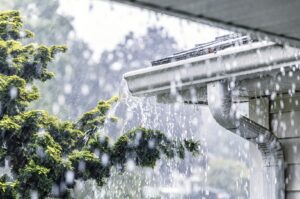
Keep reading to learn about the common causes of gutter overflow.
Gutter overflow is a common problem during rainy days. This problem might sound non-damaging and minor, but it can cause serious damage to property and health if not fixed. Water overflowing from gutters can weaken the structural integrity of your home, making it prone to further damage. Gutters are crucial in directing rainwater away from your foundation and preventing water damage. Keep reading to learn about the common causes of gutter overflow.
Improper Gutter Installation
One of the main reasons for gutter blockage causing overflow is improper installation of gutters, which is why this step of installing gutters should be taken seriously, and a trusted professional team is recommended. When gutters are not installed properly, the following issues occur:
- Incorrect pitch or tilt
- Gutters are too narrow
- Gutters are less
- Breakage during installation
- Too many seams
- Breakage during installation
- Use of faulty or low-quality gutter equipment
- Selection of the wrong type of gutter guard
Clogged Gutters
When debris is left in your gutter system, it affects the way rainwater drains from the roof. Debris traps the water, causing the gutters to overflow. In colder climates, ice dams on the roof can block the flow of water into the gutters, causing overflow when the ice melts. This can become a hazard as the water may seep into the walls and ceilings.
Clogged downspouts can impede water flow and cause overflow. Regular maintenance, such as checking and clearing downspouts, is important. You should get your residential gutters cleaned at least twice a year for best results.
Wrong Gutter Size
If your gutters are not the right size for your home, they may struggle to handle heavy rain, resulting in water spillover. This can lead to water pooling around the foundation, potential structural damage, and an increased risk of water entering your home. Upgrading to larger gutters or increasing the number of downspouts can help address this issue and enhance your gutter system’s effectiveness in managing rainfall.
Inadequate Number of Downspouts
Insufficient or improperly positioned downspouts can lead to water backing up in the gutters. To enhance water drainage and prevent overflow, consider adding more downspouts or repositioning existing ones. This ensures a more balanced and effective water distribution, reducing the risk of clogs and allowing for smoother drainage from the gutters.
Improper Roof Pitch
Misalignment in rain gutters refers to a situation where the gutters are not properly positioned, affecting their ability to channel and direct rainwater. This misalignment is primarily influenced by two factors: pitch and tilt.
- Pitch: The pitch of the gutters refers to the angle or slope at which they are installed. If the pitch is inadequate, meaning it is too shallow or too steep, it can lead to problems. A shallow pitch might result in water pooling in the gutters, especially during heavy rainfall, increasing the risk of overflow. On the other hand, an overly steep pitch may cause water to flow too quickly, potentially leading to overshooting the gutters.
- Tilt: The tilt of the gutters is related to their alignment with the house. Gutters should be tilted adequately towards the downspouts to ensure adequate water flow. If the gutters are tilted away from the house, water may accumulate on the side farthest from the downspout, increasing the likelihood of overflow.
Professional Gutter Repair and Installation
Thank you for considering Gutter Freedom as your preferred choice for gutter installation, protection, and repair. With over ten years of proven excellence, we bring our expertise to your doorstep and ensuring that your home is equipped with a gutter system that stands the test of time. Contact us today to experience the Gutter Freedom and Home difference – where quality, experience, and customer satisfaction converge. Please reach out to us at 727-266-0355 for the fastest service. For other inquiries, please contact us via email at [email protected].
